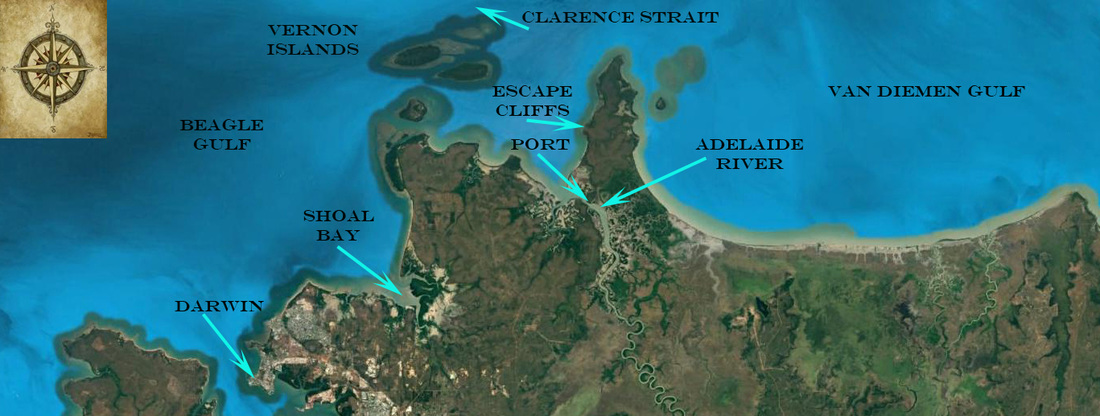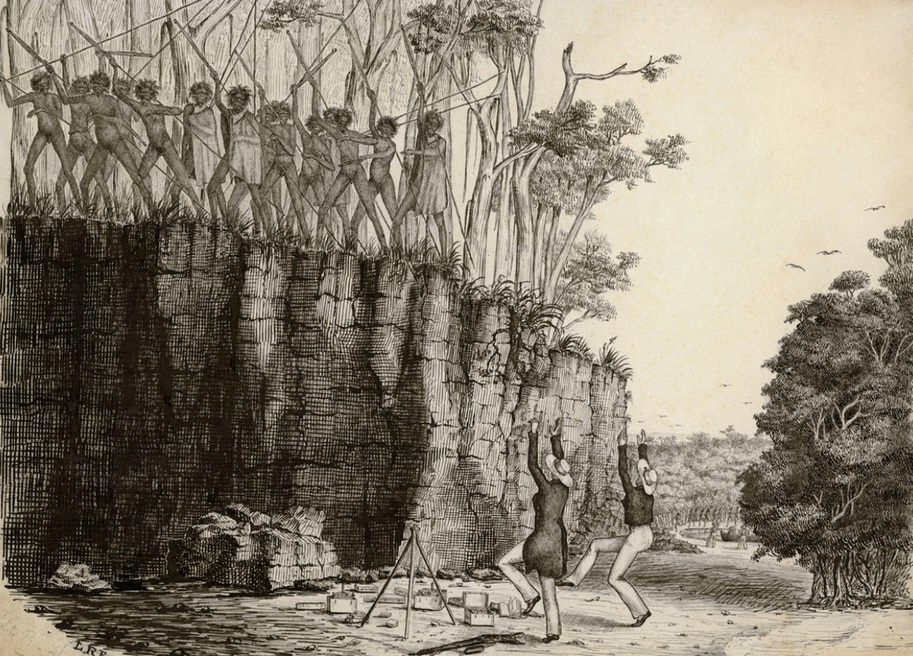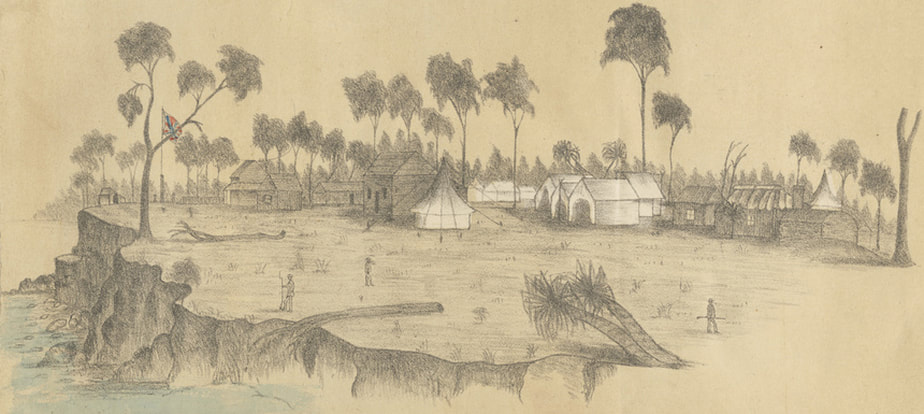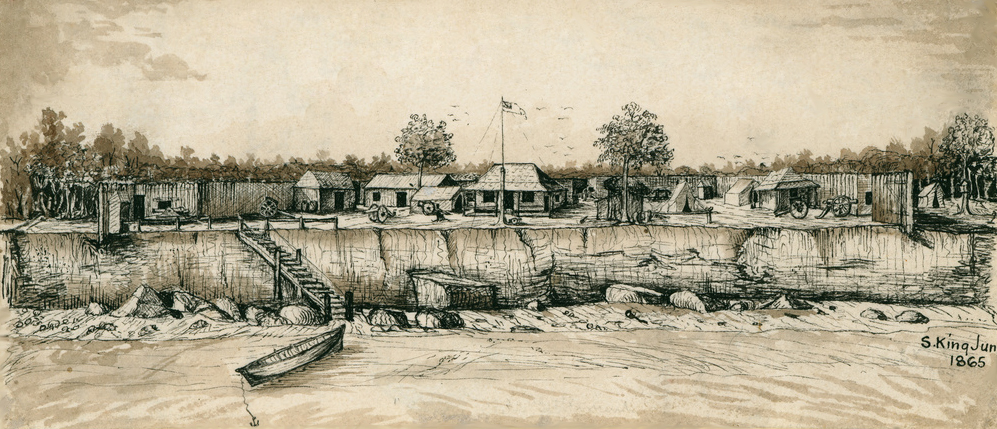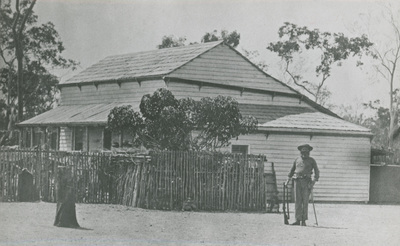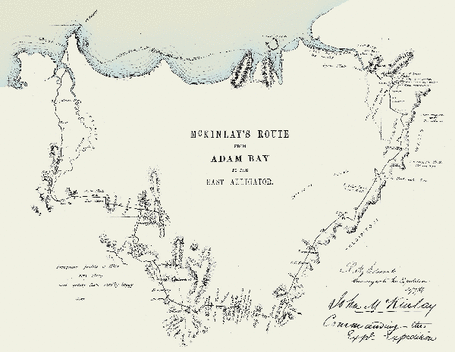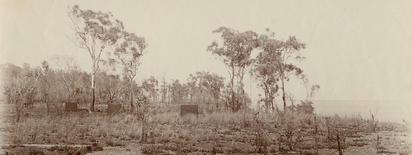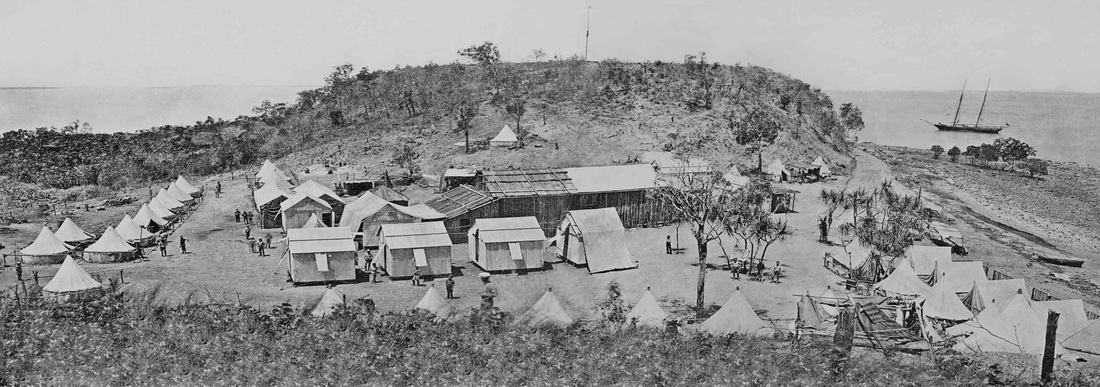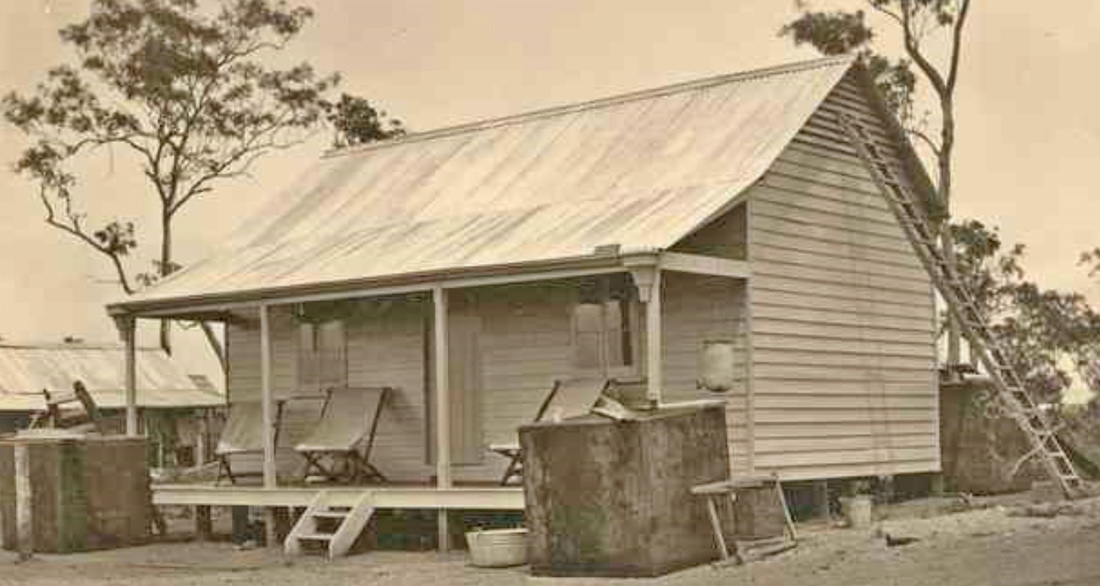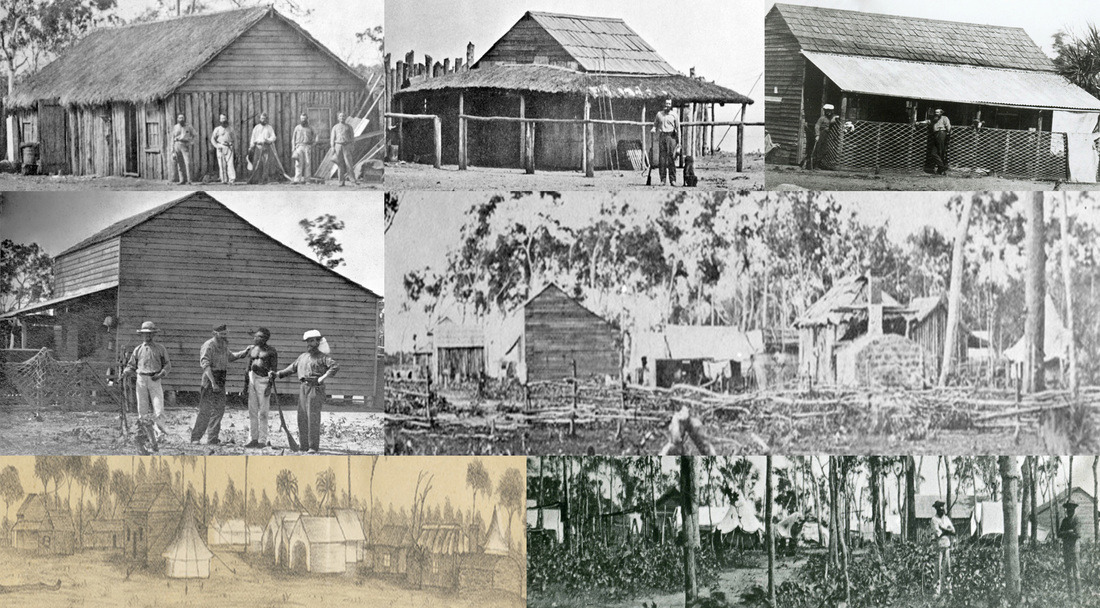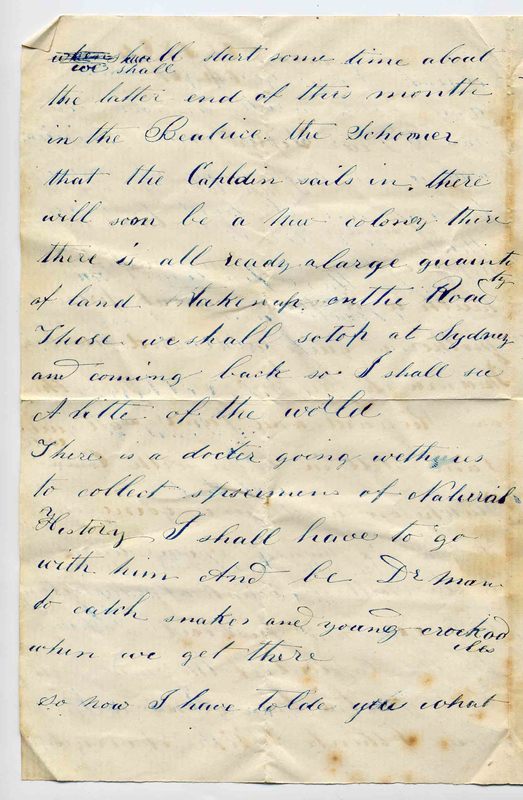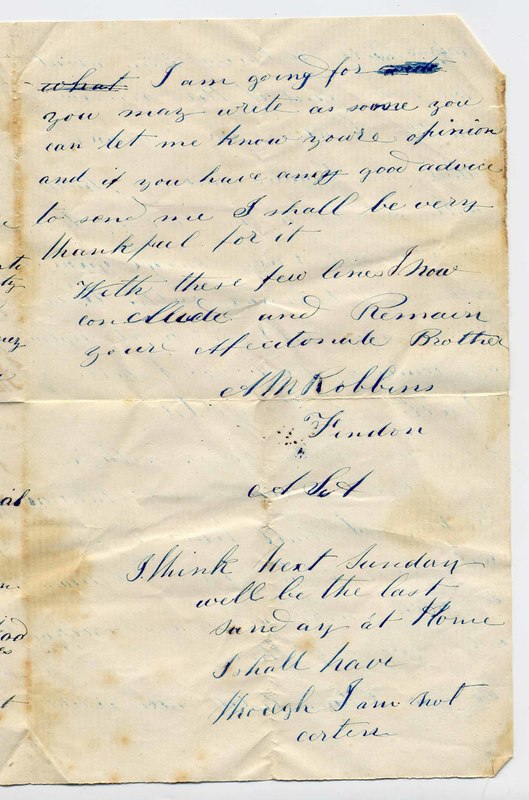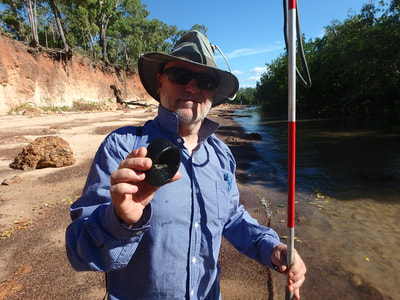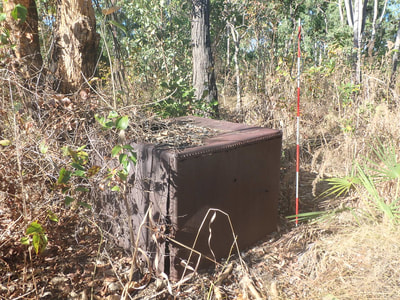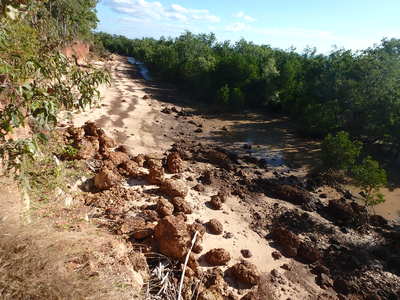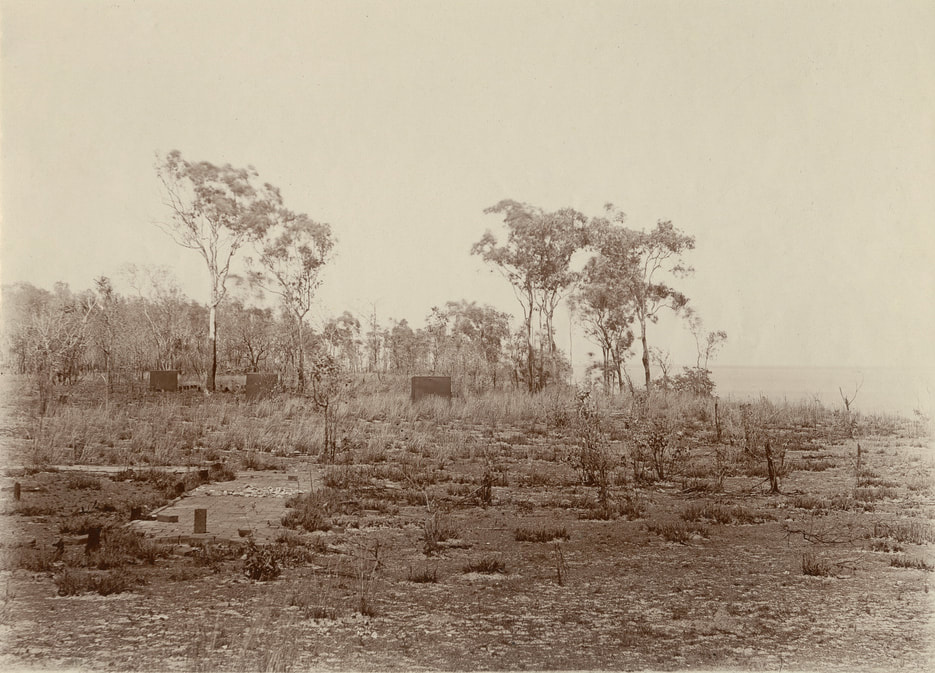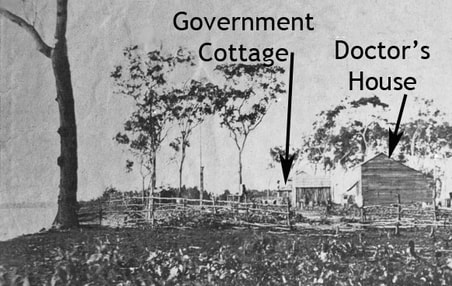ESCAPE CLIFFS 1864-66
CAPE HOTHAM NT
South Australia's Northern Capital
HMS Beagle - Escape Cliffs & the Adelaide River
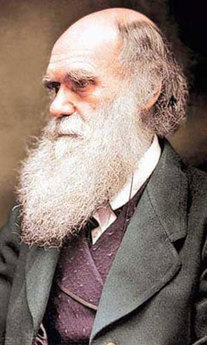
Some of the most important names in Australian exploration are associated with the discovery of the Adelaide River and the world's most famous ship of science, HMS Beagle, which had carried Charles Darwin on a five year journey around the world in search of the origin of species.
Many of the crew from that voyage (Wickham, Stokes, Fitzmaurice & Forsyth) were still with the Beagle for the Third Voyage which furnished Admiralty Charts of much of the Australian coast and made discoveries including Port Darwin - the Fitzroy, Adelaide, Victoria and Fitzmaurice Rivers - the charting of Bass Strait, the north coast of Tasmania and the southern coast of Victoria together with the entrance and significant areas of Port Phillip Bay. Charles Darwin had been with the Beagle surveying southern Australia but was no longer among the ship's company when, on 27th July 1839, Commander Wickham anchored her in a broad bay off Clarence Strait - which he named Adam Bay - at once dispersing his men to search for a great river to carry exploration into the dark interior which would not be crossed until John McDouall Stuart reached the north coast at Chambers Bay on 24th July 1862.
"Impatient to learn the truth, Mr. Fitzmaurice was despatched to examine the head of the bay, whilst the ship was moved towards it, anchoring again one mile North-West from a very remarkable patch of low red cliffs (which from startling circumstances, hereafter to be related, were called Escape Cliffs)……On returning to the ship we found that Mr. Fitzmaurice had arrived, bringing the expected, and very gratifying intelligence, that a large river with two branches, running South-East and South, with a depth of four fathoms, emptied itself into the head of the bay."
They had discovered the Adelaide River which they named for the Queen Dowager and Adam Bay for Vice-Admiral Sir Charles Adam. It was to become the site of South Australia’s first attempt at a Northern Capital for its Northern Territory and would be called Palmerston - the original name for Darwin City & today the name of her satellite city. Sagas of triumph & disaster - not without their lighter moments. On 9 September 1839 the Beagle sailed into Darwin harbour - it was named by John Clements Wickham & John Lort Stokes for their former shipmate whose 'geologising' resonated in their memories.
Many of the crew from that voyage (Wickham, Stokes, Fitzmaurice & Forsyth) were still with the Beagle for the Third Voyage which furnished Admiralty Charts of much of the Australian coast and made discoveries including Port Darwin - the Fitzroy, Adelaide, Victoria and Fitzmaurice Rivers - the charting of Bass Strait, the north coast of Tasmania and the southern coast of Victoria together with the entrance and significant areas of Port Phillip Bay. Charles Darwin had been with the Beagle surveying southern Australia but was no longer among the ship's company when, on 27th July 1839, Commander Wickham anchored her in a broad bay off Clarence Strait - which he named Adam Bay - at once dispersing his men to search for a great river to carry exploration into the dark interior which would not be crossed until John McDouall Stuart reached the north coast at Chambers Bay on 24th July 1862.
"Impatient to learn the truth, Mr. Fitzmaurice was despatched to examine the head of the bay, whilst the ship was moved towards it, anchoring again one mile North-West from a very remarkable patch of low red cliffs (which from startling circumstances, hereafter to be related, were called Escape Cliffs)……On returning to the ship we found that Mr. Fitzmaurice had arrived, bringing the expected, and very gratifying intelligence, that a large river with two branches, running South-East and South, with a depth of four fathoms, emptied itself into the head of the bay."
They had discovered the Adelaide River which they named for the Queen Dowager and Adam Bay for Vice-Admiral Sir Charles Adam. It was to become the site of South Australia’s first attempt at a Northern Capital for its Northern Territory and would be called Palmerston - the original name for Darwin City & today the name of her satellite city. Sagas of triumph & disaster - not without their lighter moments. On 9 September 1839 the Beagle sailed into Darwin harbour - it was named by John Clements Wickham & John Lort Stokes for their former shipmate whose 'geologising' resonated in their memories.
 H.M.S. Beagle from a sketch by John Clements Wickham.
H.M.S. Beagle from a sketch by John Clements Wickham.
"An exploring party, however, was at once formed, consisting of Captain Wickham, Lieutenant Emery, and Mr. Helpman, who - the next day being Sunday - did not leave before the morning of the 29th, with two boats and four days' provisions". They were to voyage more than 100kms up river past Goat Island and on through the 'S' bends to the extent of dry season navigation below where the Marraki Road now crosses the stream. Meanwhile Lieutenant Stokes went ashore: - 'Near Escape Cliffs I met a small family of natives, consisting of an elderly man, his wife, and four children; by degrees, advancing alone, I contrived to get near enough to make the woman a present of a handkerchief, in return for which she gave me a large leaf of the cabbage palm, that was slung across he back. I at length drew all the family around me, the eldest child, a youth of about 15, being the most timid. He had a small piece of wood two feet long, sticking through the cartilage of his nose. His teeth & those of the other children were quite perfect, but in the father & mother two of the upper front ones were gone, as we before noticed was the case with the natives at Port Essington, where this ceremony is performed after marriage.'
A few days after my interview with the natives, 'Mr. Fitzmaurice went ashore to compare the compasses. From the quantity of iron contained in the rocks, it was necessary to select a spot free from their influence. A sandy beach at the foot of Escape Cliffs was accordingly chosen. The observations had been commenced, and were about half completed, when on the summit of the cliffs, which rose about twenty feet above their heads, suddenly appeared a large party of natives with poised and quivering spears, as if about immediately to deliver them. Stamping on the ground, and shaking their heads to and fro, they threw out their long shaggy locks in a circle, whilst their glaring eyes flashed with fury as they champed and spit out the ends of their long beards.* (*Footnote. A custom with Australian natives when in a state of violent excitement.) They were evidently in earnest, and bent on mischief.
It was, not a little surprising to behold this paroxysm of rage evaporate before the happy presence of mind displayed by Mr. Fitzmaurice, in immediately beginning to dance & shout, though in momentary expectation of being pierced by a dozen spears. In this he was imitated by Mr. Keys, who was assisting in the observations, & who at the moment was a little distance off & might have escaped. Without, however, thinking of himself, he very nobly joined his companion in amusing the natives; and they succeeded in diverting them from their evident evil designs, until a boat landing in a bay near drew off their attention.'
It was, not a little surprising to behold this paroxysm of rage evaporate before the happy presence of mind displayed by Mr. Fitzmaurice, in immediately beginning to dance & shout, though in momentary expectation of being pierced by a dozen spears. In this he was imitated by Mr. Keys, who was assisting in the observations, & who at the moment was a little distance off & might have escaped. Without, however, thinking of himself, he very nobly joined his companion in amusing the natives; and they succeeded in diverting them from their evident evil designs, until a boat landing in a bay near drew off their attention.'
'Messrs. Fitzmaurice and Keys had firearms lying on the ground within reach of their hands; the instant, however, they ceased dancing, an attempted to touch them, a dozen spears were pointed at their breasts. Their lives hung upon a thread, and their escape must be regarded as truly wonderful, and only to be attributed to the happy readiness with which they adapted themselves to the perils of their situation. This was the last we saw of the natives in Adam Bay, and the meeting is likely to be long remembered by some, and not without pleasant recollections; for although, at the time, it was justly looked upon as a very serious affair, it afterwards proved a great source of mirth'. (John Lort Stokes, Discoveries in Australia) The sketch above is by Lewis Roper Fitzmaurice after whom the Fitzmaurice River near the NT/WA border is named. The Roper River is named for one of Leichhardt's party.
The First Northern Territory Survey Expedition June 1864

On 21 June 1864 a small fleet of pioneers from Adelaide in the Beatrice, Henry Ellis & Yatala arrived at Adam Bay which the newly appointed Government Resident Colonel Boyle Travers Finniss had courageously anointed as the site of the new northern settlement.
The 40 strong party is a roll call of Territory identities including the chief surveyor JT Manton - Frederick Litchfield, John Davis of the McKinlay Expedition - EJ Packard - S King & WP Auld of Stuart's successful expedition - W & G McMinn & E Ward the postmaster. The new settlement was proclaimed Palmerston to honour the Prime Minister of the United Kingdom - the name would subsequently be applied to the settlement at Port Darwin that became Darwin & finally to its satellite city.
The 40 strong party is a roll call of Territory identities including the chief surveyor JT Manton - Frederick Litchfield, John Davis of the McKinlay Expedition - EJ Packard - S King & WP Auld of Stuart's successful expedition - W & G McMinn & E Ward the postmaster. The new settlement was proclaimed Palmerston to honour the Prime Minister of the United Kingdom - the name would subsequently be applied to the settlement at Port Darwin that became Darwin & finally to its satellite city.
Northern Territory Survey Expedition [NLA B 11347]
'Composite of portraits of officers of First Northern Territory Survey, Expedition, 1864 to 1867. J.T. Manton, E. Ward, F.E. Goldsmith, B.T. Finniss, W. Pearson, S. King Sen., J. Davis. B.T. Finniss was appointed first Government Resident in the Northern Territory and tasked with establishing the capital city at a site suitable for a town and a port with good accessibility to the hinterland. At this stage Finniss was 57 with only 10 years experience in the army and only 4 years as a surveyor. Surveyor John Manton was second in command of a complement of 40 men. Upon arrival they proclaimed a colony around a barrel of beer in a tent.'
Finniss, Boyle Travers, 1807-1893
Davis, John, 1829-1885 Goldsmith, F. E. King, Stephen, 1806-1882 Ward, Ebenezer, 1837-1917 Pearson, William, 1829-1905 Manton, J. T. (James Thomas), -1899 |
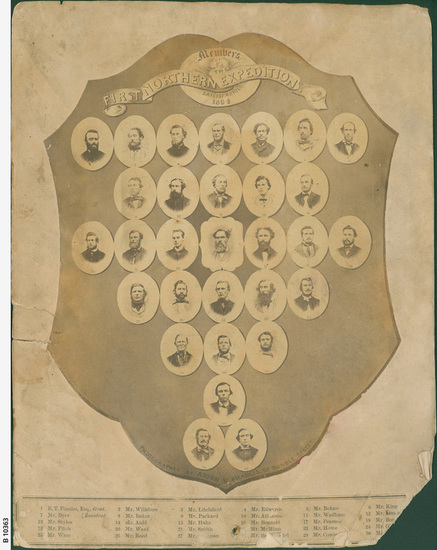 SLSA B-10363 1st Expedition departed Adelaide April 1864
SLSA B-10363 1st Expedition departed Adelaide April 1864
B. T. Finniss, Government Resident, salary £1,000 per annum.
J T. Manton, Engineer and Surveyor. £500 per annum.
F. E. Goldsmith, Surgeon and Protector of Aborigines, £400 per annum.
E. Ward, Clerk in charge, Accountant, and Postmaster, £350 per annum.
W. Pearson, Surveyor, £350 per annum.
S. King, Storekeeper and Superintendent of Stock, £280 per annum.
John Davis, Assistant Storekeeper, £200 per annum.
R. Watson, Draftsman, £160 per annum.
J. W. O. Bennett, Draftsman, £120 per annum.
James Wadham, Junior Surveyor, £120 per annum.
A. R. Hamilton, Junior Surveyor, £120 per annum.
W. McMinn, chainman, 6s. per day.
Frank J. Packard, chainman, 6s. per day.
J. R. Atkinson, chainman, 6s. per day.
F. R. Finniss, chainman, 6s. per day.
D. B. Wiltshire, chainman and able seaman, 6s. per day.
Chas. W. Machell, chainman and able seaman, 6s. per day.
M. E Fitch, chainman and able seaman, 6s. per day.
W. Read, chainman and able seaman, 6s. per day.
William Moorshead, carpenter, 7s. per day.
John A. Howe, carpenter, 7s, per day.
Thomas Braman, blacksmith, 7s. per day.
Bastin Boucaut, labourer, 5s. per day.
James Gilbert, labourer, 5s. per day.
R. J. Ware, labourer, 5s. per day.
John F. Roberts, labourer, 5s. per day.
W. S. Murray, labourer, 5s. per day.
Charles Hake, labourer, 5s. per day.
F. H. Litchfield, labourer, 5s. per day.
J T. Manton, Engineer and Surveyor. £500 per annum.
F. E. Goldsmith, Surgeon and Protector of Aborigines, £400 per annum.
E. Ward, Clerk in charge, Accountant, and Postmaster, £350 per annum.
W. Pearson, Surveyor, £350 per annum.
S. King, Storekeeper and Superintendent of Stock, £280 per annum.
John Davis, Assistant Storekeeper, £200 per annum.
R. Watson, Draftsman, £160 per annum.
J. W. O. Bennett, Draftsman, £120 per annum.
James Wadham, Junior Surveyor, £120 per annum.
A. R. Hamilton, Junior Surveyor, £120 per annum.
W. McMinn, chainman, 6s. per day.
Frank J. Packard, chainman, 6s. per day.
J. R. Atkinson, chainman, 6s. per day.
F. R. Finniss, chainman, 6s. per day.
D. B. Wiltshire, chainman and able seaman, 6s. per day.
Chas. W. Machell, chainman and able seaman, 6s. per day.
M. E Fitch, chainman and able seaman, 6s. per day.
W. Read, chainman and able seaman, 6s. per day.
William Moorshead, carpenter, 7s. per day.
John A. Howe, carpenter, 7s, per day.
Thomas Braman, blacksmith, 7s. per day.
Bastin Boucaut, labourer, 5s. per day.
James Gilbert, labourer, 5s. per day.
R. J. Ware, labourer, 5s. per day.
John F. Roberts, labourer, 5s. per day.
W. S. Murray, labourer, 5s. per day.
Charles Hake, labourer, 5s. per day.
F. H. Litchfield, labourer, 5s. per day.
|
W. P. Auld, labourer, 5s. per day.
H. Baumgertel, labourer and miner, 5s. per day. Samuel Baker, labourer, 5s. per day. Alaric Ward, labourer, 5s. per day. Francis Edwards, labourer, 5s. per day. H. T. Styles, labourer, 5s. per day. John Bonn, labourer and able seaman, 5s. per day. Thomas King, labourer and able seaman, 5s. per day. John Cowie, shoemaker and labourer, 6s. per day. William Smith, labourer, 5s. per day. John Dyer, labourer and bullock-driver, 5s. per day. Stephen Chandler, labourer, 5s. per day. |
'The whole of the party under Mr. Finniss have been enrolled under the Volunteer Act, and are to receive rations in addition to pay for 12 months, during which period they are severally bound by agreement to obey the orders and directions of the Government Resident.'
The Second Northern Territory Survey Expedition December 1864
 Composite group portrait of second party of settlers in the NT 'Copied from a photo lent by Mr. G.T. Saunders and lent to Archives for reproduction' SLSA B4694
Composite group portrait of second party of settlers in the NT 'Copied from a photo lent by Mr. G.T. Saunders and lent to Archives for reproduction' SLSA B4694
The paddle steamer South Australian arrived on 5th December 1864 with surveyors RH Edmunds & HD Packard - the first women Mrs Packard & Mrs Bauer along with the representative of the 200 land-order holders, Jefferson Stow who detested the place & Finniss on sight.
Finniss visited Port Darwin which he rejected as "too landlocked" - the lack of a major river to bring trade goods from the interior was a critical factor in Finniss' rationale. Ideally a settlement would be at the head of navigation where freshwater dominates the flow but this was not available in northern Australia. The necessity for steam tugs to act as lighters up the rivers demanded coal supplies or at least dry timber.
The raison d'etre of a northern capital had changed from extending power to the trade routes through the Spice Islands up to China, as at Fort Dundas, and providing respite for sailing ships such as at Port Essington. Escape Cliffs was intended as a commercial port exploiting the untapped riches of the interior that lay in cattle, sheep and agriculture.
The surveying and selling of land allotments to English investors was the pivotal factor of financial viability for the new settlement & port but also for the infant colony of South Australia which had been proclaimed on 28th December 1836 and had been granted its Northern Territory in 1863.
Finniss visited Talc Head in Port Darwin for the purpose of quarrying 6 tons of quartz which was sent to Adelaide for assay aboard the Beatrice. It was the fine sandstone at Talc Head that reminded the men of the Beagle to name the port for their relentlessly 'geologising' shipmate on their voyage around the world.
On 6th May 1865 Jefferson Stow and five fellow non-mariners took a 23ft open boat and guided by a pocket compass began a two month, 3000 mile voyage to Fremantle - upon arrival & disembarkation their boat capsized and sank. By August Stow was back in Adelaide and Finniss was duly recalled being replaced as Resident by Manton.
A frenzy of Territory exploration and discovery ensued - recording many first and completing many hazardous journeys but it is the saga of the McKinlay party's survival at the hands of 2-i-c RH Edmunds that eclipses all.
Finniss visited Port Darwin which he rejected as "too landlocked" - the lack of a major river to bring trade goods from the interior was a critical factor in Finniss' rationale. Ideally a settlement would be at the head of navigation where freshwater dominates the flow but this was not available in northern Australia. The necessity for steam tugs to act as lighters up the rivers demanded coal supplies or at least dry timber.
The raison d'etre of a northern capital had changed from extending power to the trade routes through the Spice Islands up to China, as at Fort Dundas, and providing respite for sailing ships such as at Port Essington. Escape Cliffs was intended as a commercial port exploiting the untapped riches of the interior that lay in cattle, sheep and agriculture.
The surveying and selling of land allotments to English investors was the pivotal factor of financial viability for the new settlement & port but also for the infant colony of South Australia which had been proclaimed on 28th December 1836 and had been granted its Northern Territory in 1863.
Finniss visited Talc Head in Port Darwin for the purpose of quarrying 6 tons of quartz which was sent to Adelaide for assay aboard the Beatrice. It was the fine sandstone at Talc Head that reminded the men of the Beagle to name the port for their relentlessly 'geologising' shipmate on their voyage around the world.
On 6th May 1865 Jefferson Stow and five fellow non-mariners took a 23ft open boat and guided by a pocket compass began a two month, 3000 mile voyage to Fremantle - upon arrival & disembarkation their boat capsized and sank. By August Stow was back in Adelaide and Finniss was duly recalled being replaced as Resident by Manton.
A frenzy of Territory exploration and discovery ensued - recording many first and completing many hazardous journeys but it is the saga of the McKinlay party's survival at the hands of 2-i-c RH Edmunds that eclipses all.
The 2500 mile 'Voyage of the Forlorn Hope'
 Boyle Finnis
Boyle Finnis
'The new arrivals were nearly all Government officials, but three of them were private settlers seeking a fortune and experience. One was a German scientist, who was accompanied by his wife and child. He was mainly interested in meteorology. The other two free settlers were Mr Stuckey and Mr J. P. Stow, experienced South Australian colonists. A Government surveyor also brought his wife and child with this party.' (The Forlorn Hope - A Saga of the Sixties - Frank Clune 1945 )
To Mr Stow, seated in his tent, wistfully looking at the anchored Bengal, came a man with a proposition. The visitor was Arthur Hamilton, a fed-up young surveyor in the Government service. His proposal was that a whaleboat should be purchased from the skipper of the Bengal, and that a party should be made up, led by Mr Stow, to explore the coast westwards for 600 miles, as far as the settlement of Camden Harbour. “It’s rather a forlorn hope,” said Mr Stow, “but I’m willing to try it!”
To Mr Stow, seated in his tent, wistfully looking at the anchored Bengal, came a man with a proposition. The visitor was Arthur Hamilton, a fed-up young surveyor in the Government service. His proposal was that a whaleboat should be purchased from the skipper of the Bengal, and that a party should be made up, led by Mr Stow, to explore the coast westwards for 600 miles, as far as the settlement of Camden Harbour. “It’s rather a forlorn hope,” said Mr Stow, “but I’m willing to try it!”
 Bengal with Gulnare alongside - Telegraph Fleet 1871
Bengal with Gulnare alongside - Telegraph Fleet 1871
Five other mangrove-sated colonists were invited to join the boat-party, and accepted the invitation with alacrity. Two of them were seamen, the other three employed in the Government Surveying Service. All were of good physique and stout-hearted. Going aboard the Bengal—still at anchor in the bay — Stow negotiated with the skipper, a simple-minded Swede, for the purchase of a boat. The skipper was not as simple-minded as he looked. His price was £60, take it or leave it—a staggering sum in those days of cheap labour and cheap commodities—but the buyers were at the seller’s mercy, so the deal was done.
The boat, like the skipper, was made in Sweden. She was 23 feet in length, 6 feet across the beam, and 2 feet deep, with two masts and spritsails, and three pairs of oars. On May 4—two days before the Bengal sailed away— the purchase was completed and the boat brought ashore. Energetically, the seven men made ready for an early departure. They fitted washboards and some decking at bow and stern, also a jib-sail, and made lockers to hold provisions. Then they named her THE FORLORN HOPE. There was much head-shaking among the onlookers at this name of ill-omen, but the satirical seven were satisfied that the name was appropriate, so they kept it.
The boat, like the skipper, was made in Sweden. She was 23 feet in length, 6 feet across the beam, and 2 feet deep, with two masts and spritsails, and three pairs of oars. On May 4—two days before the Bengal sailed away— the purchase was completed and the boat brought ashore. Energetically, the seven men made ready for an early departure. They fitted washboards and some decking at bow and stern, also a jib-sail, and made lockers to hold provisions. Then they named her THE FORLORN HOPE. There was much head-shaking among the onlookers at this name of ill-omen, but the satirical seven were satisfied that the name was appropriate, so they kept it.

'On May 6, 1865, after the Bengal’s departure, the Forlorn Hopers put their luggage and provisions aboard their little vessel. They had 200lb of biscuits, 120 lb of tinned beef, 70 gallons of water, and some firewood. The gear included a camp-oven and an iron bucket for cooking, also several shot-guns and ammunition, fishing lines and hooks, maps, charts, compasses and sextants, a small medicine-chest—and two bottles of beer. {Also a chest of photographic apparatus belonging to Messrs. Hamilton and Hake. JP Stow}
Towards sundown of that same day, the whole population of Palmerston—except the Government Resident ~ Boyle Finniss, and a couple of his senior officials — assembled on the shore to bid the seven sturdy adventurers God-speed. They were leaving on the tide, which was nearly full. The Palmerstonians were also full, as they toasted the Forlorn Hope and her crew in beer which the Bengal had brought. After many cheers and beers, the sturdy seven went aboard. Their names were: J.P. Stow, j.r., leader of the party; Arthur Hamilton and William McMinn, surveyors and navigators; John White and James Davis, seamen; Charles Hake and Frank Edwards, surveyors’ chainmen.
John Whiter who had been in the pilot service in Victoria and South Australia, was appointed Sailing Master and a good man he was, too, at handling a boat. All aboard, and renewed beery cheers came from the Palmerstonians on shore as the flag of the Forlorn Hope was raised to the masthead. It was a pennant with a strange device: FINIS CORONAT OPUS - translated freely by one wag as Finniss corroborees on the opposition.
Towards sundown of that same day, the whole population of Palmerston—except the Government Resident ~ Boyle Finniss, and a couple of his senior officials — assembled on the shore to bid the seven sturdy adventurers God-speed. They were leaving on the tide, which was nearly full. The Palmerstonians were also full, as they toasted the Forlorn Hope and her crew in beer which the Bengal had brought. After many cheers and beers, the sturdy seven went aboard. Their names were: J.P. Stow, j.r., leader of the party; Arthur Hamilton and William McMinn, surveyors and navigators; John White and James Davis, seamen; Charles Hake and Frank Edwards, surveyors’ chainmen.
John Whiter who had been in the pilot service in Victoria and South Australia, was appointed Sailing Master and a good man he was, too, at handling a boat. All aboard, and renewed beery cheers came from the Palmerstonians on shore as the flag of the Forlorn Hope was raised to the masthead. It was a pennant with a strange device: FINIS CORONAT OPUS - translated freely by one wag as Finniss corroborees on the opposition.
They were headed for Camden Harbour a lonely outpost 230 miles NE of where Broome is today. After 23 days at sea, suffering storm and beaching on a reef 20 miles off Cape Bougainville they made the harbour. Remarkably, Hamilton & Hake exposed plates to create images of Camden Harbour.
The situation at Camden Harbour was worse, if anything, than that at Palmerston. The sheep are nearly all dead, the country worthless, and the whole settlement a failure. For five days the Forlorn-Hopers remained at Camden Harbour, listening to the colonists’ tales of woe. Instead of waiting for the relief-ship—which might not come for months—the Forlorn-Hopers decided to resume their open-boat voyage and to make for the next settlement, at Nicol Bay, some hundreds of miles further south. They obtained provisions sufficient for this journey and got a new anchor and rudder fitted. On June 3 they set sail, but did not clear Camden Harbour until 4 a.m. next day. Setting their course west-south-west, they stood out to sea. The land receded, and was soon out of sight. “Heigho for Nicol Bay!” sang the seven merry mariners—but then came a storm which blew them 200 miles out to sea, and they were all alone on the vasty deep of the Indian Ocean.
They endured nine sleepless days of gales during which they cut off the mainmast and let it float away. On 12th June the storm abated. Seventeen days after leaving Camden Harbour the made landfall but found no settlement. There was no settlement at Nicol Bay and they had sailed 50 miles past it in the night. Four days later they once again put to sea this time for Geraldton in Champion Bay, ‘a long and rugged journey down a dangerous coast’.
On 3rd July they landed on Dorre Island for a feast of snapper & shags – then headed down past Dirk Hartog Island - across Shark Bay and down to Champion Bay which they made on 8th July after some 2000 miles and sixty-three days from Escape Cliffs. Mistaken for shipwrecked mariners & escaped convicts, some fifty inhabitants helped drag them ashore and up to Barton’s Hotel on the beach for rum-toddys. Geraldton consisted of about 60 houses, nearly all built of stone, with two hotels, several churches, stores, a gaol and a jetty, a flagstaff, and a prosperous hinterland of farms, with a couple of copper mines whilst the back copies of the newspapers told of the assassination of President Lincoln and the marauding bushrangers Morgan, Ben Hall and Gilbert in N.S.W.
After a week in Geraldton, five of the voyagers sailed for Fremantle on a timber-barge with the Forlorn Hope as deck-cargo. The two photographers, Hamilton and Hake, remained in Geraldton and started a ‘fizzog-taking’ business. Five days later they made Fremantle, where they sold the Forlorn Hope to the skipper of a merchant vessel, who promptly capsized her in the harbour. They took the steamer to Perth then 255 miles by coach to Albany, where they boarded the steamer Rangatira, arriving at Port Adelaide on August 12th just over three months after escaping Escape Cliffs.
Their arrival at Adelaide caused a sensation, Finniss was duly recalled, being replaced as Resident by Manton. Escape Cliffs was abandoned and Palmerston shifted to Port Darwin where William McMinn's brother Gilbert, who was also at Escape Cliffs, would return in 1869 under Goyder as senior surveyor of the new city and acting Government Resident in 1883. A frenzy of Territory exploration ensued - recording many first with many hazardous journeys but none to equal the odyssey of the Forlorn Hope. It was a triumph of seamanship & endurance worthy of their pennant - FINIS CORONAT OPUS - The Knockout Ends the Fight.
Their journey should rate amongst the great open-boat journeys of Bligh from Tahiti to Timor in 1789 - the Bryants from Sydney to Koepang in 1791 and Shackleton from Elephant Island to South Georgia in 1916 aboard the James Caird after the loss of the Endurance in the ice. However, for sheer unbridled horror, it is the saga of the McKinlay party's survival at the hands of RH Edmunds in the Horse Hide Boat that eclipses all and alone amongst all other voyages it will never be re-enacted.
The situation at Camden Harbour was worse, if anything, than that at Palmerston. The sheep are nearly all dead, the country worthless, and the whole settlement a failure. For five days the Forlorn-Hopers remained at Camden Harbour, listening to the colonists’ tales of woe. Instead of waiting for the relief-ship—which might not come for months—the Forlorn-Hopers decided to resume their open-boat voyage and to make for the next settlement, at Nicol Bay, some hundreds of miles further south. They obtained provisions sufficient for this journey and got a new anchor and rudder fitted. On June 3 they set sail, but did not clear Camden Harbour until 4 a.m. next day. Setting their course west-south-west, they stood out to sea. The land receded, and was soon out of sight. “Heigho for Nicol Bay!” sang the seven merry mariners—but then came a storm which blew them 200 miles out to sea, and they were all alone on the vasty deep of the Indian Ocean.
They endured nine sleepless days of gales during which they cut off the mainmast and let it float away. On 12th June the storm abated. Seventeen days after leaving Camden Harbour the made landfall but found no settlement. There was no settlement at Nicol Bay and they had sailed 50 miles past it in the night. Four days later they once again put to sea this time for Geraldton in Champion Bay, ‘a long and rugged journey down a dangerous coast’.
On 3rd July they landed on Dorre Island for a feast of snapper & shags – then headed down past Dirk Hartog Island - across Shark Bay and down to Champion Bay which they made on 8th July after some 2000 miles and sixty-three days from Escape Cliffs. Mistaken for shipwrecked mariners & escaped convicts, some fifty inhabitants helped drag them ashore and up to Barton’s Hotel on the beach for rum-toddys. Geraldton consisted of about 60 houses, nearly all built of stone, with two hotels, several churches, stores, a gaol and a jetty, a flagstaff, and a prosperous hinterland of farms, with a couple of copper mines whilst the back copies of the newspapers told of the assassination of President Lincoln and the marauding bushrangers Morgan, Ben Hall and Gilbert in N.S.W.
After a week in Geraldton, five of the voyagers sailed for Fremantle on a timber-barge with the Forlorn Hope as deck-cargo. The two photographers, Hamilton and Hake, remained in Geraldton and started a ‘fizzog-taking’ business. Five days later they made Fremantle, where they sold the Forlorn Hope to the skipper of a merchant vessel, who promptly capsized her in the harbour. They took the steamer to Perth then 255 miles by coach to Albany, where they boarded the steamer Rangatira, arriving at Port Adelaide on August 12th just over three months after escaping Escape Cliffs.
Their arrival at Adelaide caused a sensation, Finniss was duly recalled, being replaced as Resident by Manton. Escape Cliffs was abandoned and Palmerston shifted to Port Darwin where William McMinn's brother Gilbert, who was also at Escape Cliffs, would return in 1869 under Goyder as senior surveyor of the new city and acting Government Resident in 1883. A frenzy of Territory exploration ensued - recording many first with many hazardous journeys but none to equal the odyssey of the Forlorn Hope. It was a triumph of seamanship & endurance worthy of their pennant - FINIS CORONAT OPUS - The Knockout Ends the Fight.
Their journey should rate amongst the great open-boat journeys of Bligh from Tahiti to Timor in 1789 - the Bryants from Sydney to Koepang in 1791 and Shackleton from Elephant Island to South Georgia in 1916 aboard the James Caird after the loss of the Endurance in the ice. However, for sheer unbridled horror, it is the saga of the McKinlay party's survival at the hands of RH Edmunds in the Horse Hide Boat that eclipses all and alone amongst all other voyages it will never be re-enacted.
n.b. Hope was the name of the boat that Flinders sailed to Sydney Cove to raise the alarm after the Cato & HMS Porpoise foundered on Wreck Reef.
Hamilton & Hake - The First NT Photographers

SLSA B-7195 The man with a shotgun is Clement Young, clerk and accountant to the NT Survey in 1865-66 with the Treasury Office behind - some nice fish spears - the cannon is a 24 pound brass howitzer for saluting & signalling - it was retrieved from Kupang by the Beatrice after the Yatala was condemned.
 Charles Hake
Charles Hake
Amongst the members of the first expedition were two photographers A.R. Hamilton, Junior Surveyor & Charles Hake, labourer. They and their box of photographic apparatus would depart on 25th May 1865 aboard the Forlorn Hope. They would remain at Geraldton to start a photography business. The image above is attributed to them in 1865 and shows the storehouse which was naturally one of the first buildings erected. It has a crude grass thatch and is mostly rough hewn local timber whilst the others below are dressed boards and shingle roofs. This may well be 1864 but in any event it is prior to the arrival of the Mermaid & Guy's image of the Horse Hide boat frame in 1866. The others are unattributed - from the similar & somewhat naïve compositions it seems likely that the others are also the work of Hamilton & Hake pictured here. The man on the right is clean shaven with a high forehead, perhaps Stephen King (6) see pen & wash sketch below. These images are likely amongst the first taken in the NT and pre-date buildings on the Adam Bay site.
 View in the Northern Territory - First camp on the Adelaide River
View in the Northern Territory - First camp on the Adelaide River
“PHOTOGRAPHS IN THE NORTHERN TERRITORY
We have seen three photographs forwarded to the Government by Mr. Finniss, Resident at the Northern Territory. One of these presents a view of the first encampment of the expedition on the Adelaide River, and whatever its imperfections, it certainly shows that an abundance of grass and timber exists in the locality. Another of them shows nine members of the party mounting guard; and a third portrays a group of naked aboriginals, whose stature appears quite imposing. The views are not well executed, and the last mentioned shows the figures as indistinctly as if it was a mere negative. The only one of the guard party at all recognisable is Mr. McMinn.” {South Australian Register Wednesday 14 December 1864 p2}
On 20 February 1865 the Advertiser reported that on the first page of the Melbourne Post there was ‘a view of the first camp on the Adelaide River, Northern Territory, from a photograph by Arthur Hamilton, the sketch having been drawn by Mr W. Wyatt, of the Adelaide Audit Office, although not so stated by the Post'.
We have seen three photographs forwarded to the Government by Mr. Finniss, Resident at the Northern Territory. One of these presents a view of the first encampment of the expedition on the Adelaide River, and whatever its imperfections, it certainly shows that an abundance of grass and timber exists in the locality. Another of them shows nine members of the party mounting guard; and a third portrays a group of naked aboriginals, whose stature appears quite imposing. The views are not well executed, and the last mentioned shows the figures as indistinctly as if it was a mere negative. The only one of the guard party at all recognisable is Mr. McMinn.” {South Australian Register Wednesday 14 December 1864 p2}
On 20 February 1865 the Advertiser reported that on the first page of the Melbourne Post there was ‘a view of the first camp on the Adelaide River, Northern Territory, from a photograph by Arthur Hamilton, the sketch having been drawn by Mr W. Wyatt, of the Adelaide Audit Office, although not so stated by the Post'.
|
Among the seven men who sailed in the Forlorn Hope were Arthur Hamilton and Charles Hake, and among the supplies stowed away on board was their chest of photographic apparatus. The Forlorn Hope left Adam Bay on 7 May 1865 and, after a voyage fraught with danger, arrived at the small, desolate settlement at Camden Harbour on 29 May, where they were received by Mr R.J. Sholl, the Government Resident. Stow, Hamilton and McMinn were accommodated in the Resident’s tent, but the four ‘men’ in the party, including Hake, apparently had to make their own arrangements. In an official dispatch dated 2 June Mr Sholl said, ‘Mr Hamilton took some photographic sketches of the camp, which are very good, taking into consideration all disadvantageous circumstances. I do not send copies because I fear that the mail-bag may become wet during the passage. Mr Hamilton will, however, I have no doubt, be willing to furnish you with copies.’ An advertisement in the Register for 26 February 1866 said, ‘Card photographs of the Northern Territory and Camden Harbour, taken by Messrs Hamilton and Hake, on sale by the Adelaide Photographic Company’.
In 1955 two views of the Escape Cliffs camp were reproduced in Jack Cato’s The Story of the Camera in Australia, in which he told how some of Hamilton & Hake’s photographs had been resurrected: ‘For nearly ninety years their pictures appeared to be lost. Various collectors advertised for them in newspapers without avail. But a few years ago Mr E.M. Christie of the Royal Victoria Historical Society discovered a considerable number of them in a private collection. They were faded and in poor condition, but he took them to George Marchant of Melbourne [son of Edwin Marchant and formerly of South Australia] who copied them with great cunning and produced a set of new negatives from which perfect prints have been made.’ Another of their photographs was reproduced in Pike and Stringer’s Frontier Territory1, and a description of some of their surviving photographs is given in The Dictionary of Australian Artists.2 1Glenville Pike and Col Stringer, Frontier Territory, Corey Books, Darwin, 1980, p. 10. 2Joan Kerr (ed.), Dictionary of Australian artists, painters, sketchers, photographers and engravers to 1870, Oxford University Press, Melbourne, 1992, p. 339. Text taken from: Noye, R.J. (2007) Dictionary of South Australian Photography 1845-1915, Art Gallery of South Australia, Adelaide. CD-ROM, pp. 152-53. Nerina Dunt 1992 https://www.daao.org.au/bio/charles-hake/biography/ |
The only weapon facing seaward is the signal gun & the stockade encloses 1 acre by bags 8ft high - the timbers are roughly that height so perhaps it is a local usage that has not troubled the OED.
|

We present our readers this month with a view; taken on the spot, of the site selected by Mr. Finnis for the capital of Northern Australia.
The sketch represents the government resident's quarters, and the tents of the expeditionary party at present located there, under the direction of Mr. John McKinlay, the well-known explorer, who relieved Mr. Finnis of his duties.
It would, perhaps, have been well had some other person than Mr. Finnis been chosen as the first commandant of the infant colony.
His administration has been marked by disorganisation, distrust, and inactivity.
Illustrated Sydney News Saturday 15 Sept. 1866
The sketch represents the government resident's quarters, and the tents of the expeditionary party at present located there, under the direction of Mr. John McKinlay, the well-known explorer, who relieved Mr. Finnis of his duties.
It would, perhaps, have been well had some other person than Mr. Finnis been chosen as the first commandant of the infant colony.
His administration has been marked by disorganisation, distrust, and inactivity.
Illustrated Sydney News Saturday 15 Sept. 1866
The Third Northern Territory Survey Expedition November 1865

In November 1865 Finniss was recalled and the explorer John McKinlay arrived at the head of a large party to search of an alternative site for Palmerston.
McKinlay left Escape Cliffs for the West Arnhem Land coastal plains in mid-January 1866 - well into the Wet Season where 95% humidity, temperatures in the high thirties during the day & high twenties at night - breeding crocodiles - squadrons of flies & mosquitoes battling sandflies for land space - nicely bogged on the mudflats & floodplains of the East Alligator River.
By May the receding waters would have allowed a reasonably comfortable overland return to Escape Cliffs but McKinlay insisted on a sea voyage. The horses were slaughtered and their hides stretched over a basket frame of sapling poles lashed with rawhide and dubbed HMS Pioneer.
For 15 days and nights they braved saltwater crocodiles, sharks and a diet of putrefying horsemeat across more than 100 miles of sea - at last staggering ashore at Escape Cliffs, emaciated and unrecognisable on the 5th July. Their boat promptly sank. The image below was taken by Michael Stewart Guy in 1866 - he was aboard the British survey schooner Beatrice pictured here whilst at Adelaide in 1881 AWM 302144. The images below show the abandoned site of Escape Cliffs and the first Palmerston.
McKinlay left Escape Cliffs for the West Arnhem Land coastal plains in mid-January 1866 - well into the Wet Season where 95% humidity, temperatures in the high thirties during the day & high twenties at night - breeding crocodiles - squadrons of flies & mosquitoes battling sandflies for land space - nicely bogged on the mudflats & floodplains of the East Alligator River.
By May the receding waters would have allowed a reasonably comfortable overland return to Escape Cliffs but McKinlay insisted on a sea voyage. The horses were slaughtered and their hides stretched over a basket frame of sapling poles lashed with rawhide and dubbed HMS Pioneer.
For 15 days and nights they braved saltwater crocodiles, sharks and a diet of putrefying horsemeat across more than 100 miles of sea - at last staggering ashore at Escape Cliffs, emaciated and unrecognisable on the 5th July. Their boat promptly sank. The image below was taken by Michael Stewart Guy in 1866 - he was aboard the British survey schooner Beatrice pictured here whilst at Adelaide in 1881 AWM 302144. The images below show the abandoned site of Escape Cliffs and the first Palmerston.
 Captain Cadell
Captain Cadell
On 22 December 1866 the paddle-steamer Eagle under Captain Cadell - who had pioneered their introduction on the Murray River - arrived at Escape Cliffs with orders to abandon the settlement. In February 1867 Cadell once again brought the Eagle to the north coast surveying for a site of 300,000 acres of good land.
Cadell navigated the Roper River for the first time and travelled extensively through the Wessels and English Company Islands - hence Cadell Straight between Elcho Island & the Napier Peninsular - Napier accompanied him.
Despite his renown, Cadell recommended a new settlement site at the mouth of the Liverpool River where Maningrida stands today. He was of course, like all the early explorers, concerned with the prospect of finding a deep river which penetrated far inland; down which the riches of the mines and the Plains of Promise could be brought to a sea port and shipped to the world. Steam was in it's infancy & struggling to find dry fuel in the Wet tropics. Within 5 years paddlewheels had given way to propellers and linesmen had discovered gold in the postholes being dug for the Overland Telegraph Line that ran to Cable Beach in Port Darwin where dedicated steam powered cable-laying ships had brought ashore the umbilical that joined Australia to the world.
Cadell navigated the Roper River for the first time and travelled extensively through the Wessels and English Company Islands - hence Cadell Straight between Elcho Island & the Napier Peninsular - Napier accompanied him.
Despite his renown, Cadell recommended a new settlement site at the mouth of the Liverpool River where Maningrida stands today. He was of course, like all the early explorers, concerned with the prospect of finding a deep river which penetrated far inland; down which the riches of the mines and the Plains of Promise could be brought to a sea port and shipped to the world. Steam was in it's infancy & struggling to find dry fuel in the Wet tropics. Within 5 years paddlewheels had given way to propellers and linesmen had discovered gold in the postholes being dug for the Overland Telegraph Line that ran to Cable Beach in Port Darwin where dedicated steam powered cable-laying ships had brought ashore the umbilical that joined Australia to the world.
Recycling to Port Darwin 1870
1864 Letter
A letter that Abner Mark Robbins of Findon, South Australia wrote to his sister Phebe Robbins in 1864, detailing the voyage he was about to embark upon to look for a suitable place for the “capital” in the Northern Territory. Source see LoneTester button below.
Sunday 6 March 1864
Dear Sister,
I now take the opportunity of sending a few lines to you hoping they will find you in good health as it leaves me at present. Mother is quite well and has been to Hindmarsh this morning. Mary Ann and Richard and family are all quite well. I am still in town with Commr Hutchison and he is going out for a six months voyage round to the Northern coast of Australasia to survey and pick out a place for the Capital of the new Northern Territory. And I am going with him. I think I shall like it very well. (page 2) We shall start some time about the latter end of this month in the Beatrice the Schooner that the Captain sails in, there will soon be a New Colony there. There is already a large quantity of land taken up on the Road(?). There we shall stop at Sydney and coming back so I shall see a little of the world.
There is a doctor going with us to collect specimens of Natural History. I shall have to go with him and be Dr Man to catch snakes and young crocodiles when we get there.
So no I have told you what (page 3) I am going for you may write as soon you can let me know your opinion and if you have any good advice to send me I shall be very thankful for it.
With these few lines I now conclude and Remain you Affectionate Brother
AM Robbins
Findon
ASA
I think next Sunday will be the last Sunday at Home I shall have though I am not certain.
Dear Sister,
I now take the opportunity of sending a few lines to you hoping they will find you in good health as it leaves me at present. Mother is quite well and has been to Hindmarsh this morning. Mary Ann and Richard and family are all quite well. I am still in town with Commr Hutchison and he is going out for a six months voyage round to the Northern coast of Australasia to survey and pick out a place for the Capital of the new Northern Territory. And I am going with him. I think I shall like it very well. (page 2) We shall start some time about the latter end of this month in the Beatrice the Schooner that the Captain sails in, there will soon be a New Colony there. There is already a large quantity of land taken up on the Road(?). There we shall stop at Sydney and coming back so I shall see a little of the world.
There is a doctor going with us to collect specimens of Natural History. I shall have to go with him and be Dr Man to catch snakes and young crocodiles when we get there.
So no I have told you what (page 3) I am going for you may write as soon you can let me know your opinion and if you have any good advice to send me I shall be very thankful for it.
With these few lines I now conclude and Remain you Affectionate Brother
AM Robbins
Findon
ASA
I think next Sunday will be the last Sunday at Home I shall have though I am not certain.
July 2017
The image at right was taken by Florenz Bleeser c1900 and it is reassuring to see that at least one of the loose bricks has not been half-inched. Also the frog depression for mortar is a useful dating guide suggesting an Adelaide origin as opposed to being made in situ - those at Fort Dundas are frogless. If this is the same slab - the water tanks suggest that it is - then a considerable amount of cliff face has been lost and the remaining archaeology is under serious threat. It would also explain why the beach below is so devoid of finds. Lidar would be nice but a sacrificial anode on the remaining tanks is achievable.
Resources
|
|
| ||||||||||||||||||
|
|
| ||||||||||||||||||
|
|
| ||||||||||||||||||
|
| |||||||||||||
